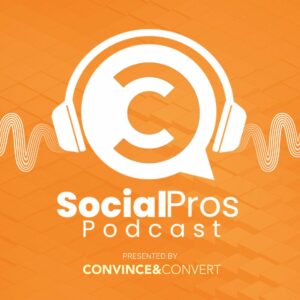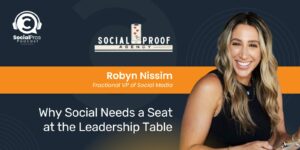Hosted By
About Social Pros Podcast:
Social Pros is one of the longest-running marketing podcasts in existence (10 YEARS and counting), and was recently recognized as the #1 Audio/Podcast Series by the Content Marketing Awards.
Our purpose? Making sure that we speak to real people doing real work in social media.
Listeners get inside stories and behind-the-scenes secrets about how teams at companies like Google, Reddit, Glossier, Zillow, Lyft, Marvel, and dozens more, staff, operate, and measure their social media programs. With 600+ episodes, the Social Pros Podcast brings the humanity of social media to the forefront, while providing incredibly useful marketing strategies that listeners can immediately implement.
Follow Social Pros on LinkedIn.
To inquire about becoming a guest or show sponsor, please email our Executive Producer, Leanna Pham, at leanna@convinceandconvert.com.
Apple Podcast Reviews:
The Social Pros podcast has quickly become a favorite in my feed! I'm consistently impressed by the engaging conversations, insightful content, and actionable ideas. I truly learn something every time I listen!
@Arlie KThis is absolutely an awesome listen for anyone in communications or social media!!
@Will31CThis podcast has become one of my staple weekly podcasts for learning about marketing! Love the conversations that they have and it's always enjoyable and educational!
@Simonstone95Love the podcast - informative, in depth and spot on for any business size.
@MissTriathlon
Brian Stokoe of Caterpillar joins the Social Pros Podcast this week to tell us about how Caterpillar’s global social media strategy works, from metrics and collaboration to blogging and safety. Read on for some of the highlights or listen below for the full podcast.
![]()
Brian Stokoe of Caterpillar joins the Social Pros Podcast this week to tell us about how Caterpillar’s global social media strategy works, from metrics and collaboration to blogging and safety. Read on for some of the highlights or listen below for the full podcast.
Listen Now
Click the play button to listen here:
[podcast]http://socialpros.podbean.com/mf/web/yfyjce/SocialProsEpisode36.mp3[/podcast]
Download the audio file:
http://socialpros.podbean.com/mf/web/yfyjce/SocialProsEpisode36.mp3
The RSS feed is: http://feeds.feedburner.com/socialprospodcast
Find us on iTunes: http://itunes.apple.com/us/podcast/convince-convert-blog-social/id499844469
Please Support Our Sponsors
Huge thanks to data-driven social media management software company Argyle Social for their presenting sponsorship, as well as Infusionsoft, Janrain, and Jim Kukral at DigitalBookLaunch. We use Argyle Social for our social engagement; we use Infusionsoft for our email; Janrain is our crackerjack social integration company, and Jim is our guest host for the podcast (and a smart guy).
Social Pros Highlights For Your Reading Enjoyment, Thanks to Speechpad for the Transcription
Caterpillar’s Global Reach
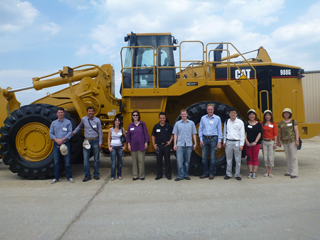
Brian: We’ve got quite a bit going on, that’s for sure. So, while I’m involved with the program in a central form, myself and my boss Kevin Espinosa, it’s really the groups around the company that pull off social around the organization that really should get the credit. We’ve been working pretty hard to empower the groups and make sure that there’s a solid strategy and direction in regards to how we present the company and how we put ourselves out there from promotion or customer support, or anything.
Jay: Are those groups by country or by product line?
Brian: Well, it’s really diverse. If you try to define Caterpillar, it diverse, because we really center our groups around our customer segments, which works well for most of our groups. So we have a whole group dedicated to the mining industry and then we have local contractors and smaller ag businesses and things like that. Then we have a whole area devoted to our engine business just on the electric power industry.
All those kinds of industrial markets that we’re in have separate marketing groups for those. But then, the thing with Caterpillar is that we are a brand that has been around for so long and we do so many different things, we also get involved in the B2C type of things with our merchandise and apparel, which is extremely popular, especially when you get outside of the U.S. So we do a variety of things.
Jay: Really? That’s interesting. I didn’t realize that the Cat merchandise is more popular outside the U.S. That’s news to me.
Brian: Yeah. I mean, we’ve got stores throughout malls in lots of countries around the world. But I think we’ve only got a handful in the U.S. So, it’s pretty interesting to see that side of our business.
Jay: So you have sort of the social media center of excellence, then, for all intents and purposes, that you and Kevin run. If a business unit wants to launch a new Facebook page or say, “Hey, we want to experiment with Instagram,” or whatever the case may be, is there an approval process for that proliferation? Do they say, “Hey, Brian and Kevin, we want to do something and you guys make sure that they kind of have their head on straight before they do it? Or what does that look like?
Brian: Yeah. I think that typically is how it works. We’ve got a little bit of reputation in the organization, I guess, when somebody starts working on some social media type of things that there are enough feelers out in the organization that say, “Let’s check in the central team on this.” We’re really a part of the brand organization, too, so brand management and the groups that really do everything from logos to managing our entire presence in physical and in digital spaces.
It’s such an interesting landscape because we don’t have defined rules of the road for saying, “We cannot use this tool,” or “We don’t want you to use this technology.” It’s typically more of a check and balance process where we talk about the business objectives, talk about what we’re trying to achieve, and then making sure that with our experience and background and tentacles related to the social media world that we are using the right tools and techniques for whatever we’re really trying to achieve.
Social Media Scoreboards, Collaboration, and Metrics
 Jay: Because there are so many different business units involved, do you have consistent kind of scoreboards or metrics or KPIs that everybody is supposed to use so that you can look at programs side by side? Or does everybody kind of just put together their own success metrics?
Jay: Because there are so many different business units involved, do you have consistent kind of scoreboards or metrics or KPIs that everybody is supposed to use so that you can look at programs side by side? Or does everybody kind of just put together their own success metrics?
Brian: Yeah, I think we’re evolving on that. We’ve made attempts in the past to put scorecards together. Typically what we find there is we can measure the very obvious but probably low value types of activities in an across the board manner. What happens is that the diversity that you see in terms of who we’re trying to talk to also relates to the diversity of what our business objectives are.
So, trying to see those specific calls to action or specific objectives that we’re trying to achieve through our social tactics, it becomes a really bit of a mishmash to figure out how does the group that cares about branding and pure reach metrics, how does that compare to groups who have a more direct line to sales numbers or parts operations or whatever?
We are constantly evolving the ways that we pull that together. But in an ideal state, we do need to summarize that and have it in a roll-up form, so we are definitely working to those types of solutions.
Jay: Do you, as a corporation, use much social media or social collaboration tools for internal use? I mean, do you use Chatter or Yammer or something along those lines to communicate across the globe?
Brian: Well, I don’t think it’s much of a secret if you are in the technology world and have never touched Caterpillar. We use IBM tools quite a bit. So, we do have a full-fledged connections community, actually multiple instances, for our internal organizations and for the extended organizations so that Caterpillar employees can work with our dealer network. We’ve only had those introduced, I want to say, within the year and we’re seeing those become more and more popular and providing value, that’s for sure.
Empowering Team Members in Social Media
Jay: I’m glad you mentioned the dealer network. I was fortunate enough to be a judge for the Caterpillar Dealer Awards recently along with Mark Schaefer, and looked at – geez, I don’t even know – 20, 30, 40 different Caterpillar dealers across the U.S. and their use of social media and digital marketing. There is some absolutely, unbelievably good work being done in that area.
It was a surprise to me – I guess it shouldn’t have been, but it was – that you have a local regional sort of Caterpillar dealer doing really first cabin, top flight kind of social media stuff. Can you talk a little bit about the dealers and how they interact with you on the brand side?
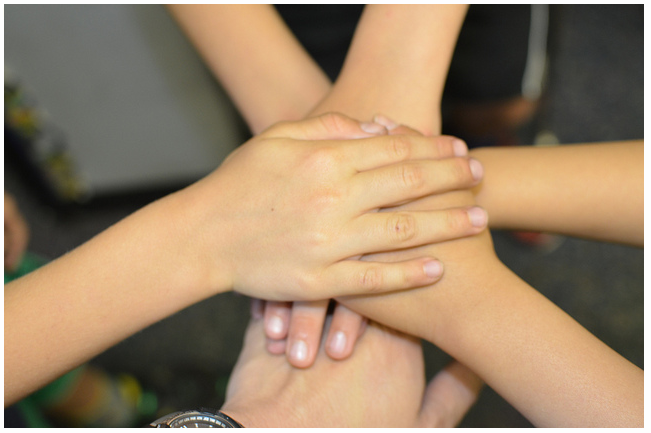 Brian: Sure. Well, first, thank you for participating in that. It was great to have yourself and Mark be involved in that process. I know our dealers really appreciated that. But, in terms of how we interact with the dealers, the customers typically don’t really know this or care, but they are wholly owned independent dealers from Caterpillar. But they have arrangements to only sell Caterpillar equipment, things like that.
Brian: Sure. Well, first, thank you for participating in that. It was great to have yourself and Mark be involved in that process. I know our dealers really appreciated that. But, in terms of how we interact with the dealers, the customers typically don’t really know this or care, but they are wholly owned independent dealers from Caterpillar. But they have arrangements to only sell Caterpillar equipment, things like that.
So, the relationship between Caterpillar and the dealer is just really strong because of that arrangement, and we do everything we can to help them out. Parts of our organization are purely focused on supporting the dealer. From the pure social media side, we have done things in the past that, I would say, are at the entry levels.
For example, we provided a complete e-learning course for all the dealers to at least get to the 101, maybe the 201 levels to give them some direction of how to get involved and how to think about managing and turning this not just from a, “Hey, I think this is cool,” to an extension of their digital presence.
So, we know that the dealers have grabbed a hold of any material that we make available to them. We’ve heard that pretty loud and clear and in the future we’re putting a lot of thought and resources towards empowering those dealers, similar to how we put focus and empower the groups inside so that they have all the right resources they need from Caterpillar. I’m pretty excited about that overall.
Jay: Yeah. That’s really exciting. Does that work the same outside of the U.S.?
Brian: Yeah, it’s pretty consistent. Even the groups inside of Caterpillar, we’ve got regionalized groups that focus on the dealers in the three regions, anyway, for all Americas, EAME and Asia Pacific, including Australia.
Corporate Blogging at Its Best
Jay: In terms of your own kind of role in the company, what did you do before you were doing social media strategy?
Brian: Yeah. Well, I’ve been at Caterpillar for just over ten years, officially. If you count internships and part-time things like that, I’m probably pushing 14 years, something like that.
Jay: That’s a long time.
Brian: Yeah, it’s been awhile and I’ve had some great opportunities. I’ve been involved with marketing efforts pretty much from day one. But in my last role, I did a lot with systems around product information being pushed to the web. Those types of things, we realize, are important and in general, with our social media strategy, we’re looking at the life cycle of what a customer does with us.
We realize that at the early stages, there’s obviously the branding awareness type of touch points where social plays a big role. But then the customer eventually gets to that point where they need the raw information. That’s where our website still comes into play in terms of being a critical piece. Then, we’re recognizing that social kind of jumps into the process in between the research and all the analysis that a customer will do before they come and talk to a dealer.
So, it’s a really cool thing that we’ve started to map out and put structure around the life cycle of these opportunities and we are putting programs in place to make sure that we have the right resources in place to build those out and be bulletproof, basically.
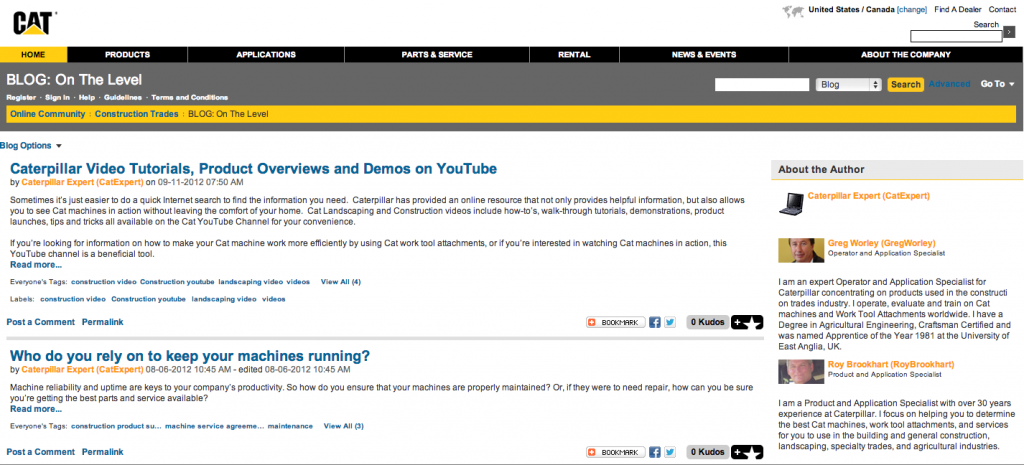 Jay: Speaking of those resources, the company has rightfully been lauded quite a bit for its blog, the Caterpillar Central Corporate Blog. Can you talk a little bit about the blog and who contributes to it and sort of what the strategy is there?
Jay: Speaking of those resources, the company has rightfully been lauded quite a bit for its blog, the Caterpillar Central Corporate Blog. Can you talk a little bit about the blog and who contributes to it and sort of what the strategy is there?
Brian: In all reality, the blogs that we’ve gotten some acclaim for really are run by the individual business units and I think that’s a good thing because it helps us get closer to the customer. One of the main pieces that’s valuable out of that is that it puts a face to the topic theme discussed, and that’s really what I think has been seen as valuable.
So for example, our electric power industry has a blog where the experts in that group actually contribute and write the content and put their picture up on it. Then, that piece of insight that these experts inside of Caterpillar is now documented and kind of put there for a conversation starter and, obviously, they can participate in the comments and let the conversation go on. But the long tail effect and all of the benefits that we’ve seen of that content being so valuable to our customers is something that’s just great.
We’re in the mode of how can we replicate that throughout as much as possible. We also see a really good example of that with our safety group. There’s a safety culture blog that we have a gentleman that just writes content all the time and it’s really great stuff if you’re in that safety culture. The content is really neat for any of the people who have to deal with safety concerns on job sites and all that sort of stuff.
Jay: Fantastic. Well, it’s amazing to me how much you’ve got going in a short period of time. I think Caterpillar is a particularly good example of a big company that has sort of centralized social media strategic resources, yourself, and Kevin and others, and then gives the individual business units enough rope to actually do their own thing with guidelines and training. So, it’s a very nice balancing act. Well done.
Brian: Thank you. Yeah, I mean, there’s a lot of really good stuff going on. We’re pretty excited about what we’re about to get into, too, because we have put a lot of focus on what’s the revised strategy for us going forward and how do we make sure that we put things in place and grow. Really, there are pillars of what we’re paying attention to.
How do we make sure we really have processes in place for social listening, customer support, promotion, thought leadership, all of these pieces that really put us in a structure aligned to build programs and projects around, that I think will take us much further in the future.
Social Media Stat of the Week: 42% of People Who Complain in Social Media Expect a Response Within 60 Minutes
Jay: In Eric’s absence, I came up with my own stat of the week and somewhat self-referentially used a stat from a blog post I wrote recently that’s based on the Social Habit study that I’m putting out soon with Jason Falls and Mark Schaefer, who I mentioned earlier, and Tom Webster from Edison Research. What we found was that 42% of people who have complained about a company in social media expect a response within 60 minutes.
42% of the people who have complained on social media expect a response within 60 minutes, and so we think of phone as a synchronous mechanism, right? We’ll wait on hold to complain. But email is asynchronous, right? We will send an email or we’ll fill out a contact form and we expect a response down the road, a few hours or maybe tomorrow. So, the question becomes do consumers think of social media as more telephone-like or more email-like?
It seems like we are tipping the balance over toward the more telephone type of very quick response, which I guess should be expected just based on how fast social media moves. But I’m not certain that many companies are fully staffed and fully prepared to handle social media complaints within 60 minutes. In fact, we also found that 24% of Americans who have contacted a brand in social media expect a reply within 30 minutes regardless of when the contact was made.
So, that means they expect you to be back in touch with them within 30 minutes, including nights and weekends. So, first and foremost, a lot of companies are not listening to social media 24 hours a day and many companies are not listening on weekends. Some are, of course, but many are not.
It seems to me, and this research backs it up, that we’re moving toward the 1-800, 24-hour a day, seven-day a week monitoring schema that we have in many cases with telephone. That’s a big hurdle to clear, I think, for a lot of brands. Brian, what do you think about that?
Brian: I think the number is a hard number to hit. But I get it. I understand and I think that I personally connect with that and recognize the expectation. Now, how a company actually pulls it off, I don’t think that all companies will be able to pull it off for one thing. But I think there are expectations with certain levels of brands out there. Where we sit with Caterpillar, customer support is pretty close to my heart. I put in our first real customer support program for social media.
While I don’t think we could hit the 60 minute mark, especially at weekends and off-hours, those are our goals and there is no question that we will be there fairly soon. But we’re in the mode where at least all messages that are actually directed to us are being reviewed. Especially on our high profile channels, where our customer support teams are looking at 1,500 to 2,000 posts on a monthly basis, where they’re categorizing and making decisions around those things.
What I guess is acceptable in my mind is I think we can make the commitment to ensuring that the customer knows that we’ve received the message and we’re working on it. I can’t guarantee that we can get the expert who knows the answer involved, especially in that hour time frame. So, I think it’s communication that’s the biggest point there. At least knowing that somebody’s handling it is what I would consider success.
Jay: Yeah. I think there’s got to be some expectation setting, right? I’m seeing more companies do this in their Twitter bio in particular, perhaps somewhat less so on Facebook. But in Twitter bios where it’s sometimes says, “Answering tweets from 8:00 a.m. to 5:00 p.m. Monday through Friday,” or whatever the circumstances are.
The same whether you have hours on the front of your retail business, smart companies are starting to post hours on their Twitter accounts to set expectations to not give people the belief that they’re listening at 3:30 in the morning on Sunday.
Brian: Right. Yeah. I think that’s a great point. You’ve got to be clear on how you’re operating, absolutely.
Jay: Because if you tell people look, expect a four-hour response and then you give them a three-hour response, they’re delighted. But if you don’t tell anybody anything and they expect a 45- minute response and you give them a three-hour response, they’re unhappy. So a lot of it’s just about expectation management, more so than the actual response time, I think.
Brian: Yeah. I think you’re right. That echoes kind of what I’m thinking there, is even a note to say, “Hey, we saw your message. It’s got to get passed to the right person. Give us a day,” or something like that, that at least closes the loop on the near term communication that’s needed.
Social Pros Shoutout
Brian: I’ve got two people that I think about and at least I follow their blogs and am interested in what they have to say. So, one guy is Tim Patterson, and these guys may be off the radar of a lot of folks.
Jay: That’s the whole idea. That’s the whole idea.
Brian: I don’t know their following is all that big. But Tim Patterson goes by the name The Trade Show Guy. We like to listen in to him to hear what he has to say. He’s got some pretty good fundamental thoughts on how to combine physical activities of shows and exhibits, and then combine everything between Foursquare and Google Plus and just whatever tool might fit that venue. So, I like him.
Jay: That’s very cool. I don’t think I know Tim. It sounds like he’d be a great guest on the show.
Brian: Yeah, absolutely. Then the second is – I hope I don’t butcher his name – Achinta Mitra. He’s basically focused on industrial B2B marketing. So I know he works with a lot of manufacturers and folks who are dealing with industrial B2B issues, and trying to be a really good advocate for how social works with these customers that get the, I don’t know, stereotype of not using social media.
Jay: Right, excellent. Well, we will make sure to link up both of those in the transcript for the show. Those were great Social Pros shout outs. Brian, it was fantastic to have you on this show. I’m really glad that you were able to take the time to do it. I love what you’re doing at Caterpillar. We’re delighted to be involved from time to time and just thank you. Thanks for being here.
Brian: I appreciate it. It was great.
See you next week!
